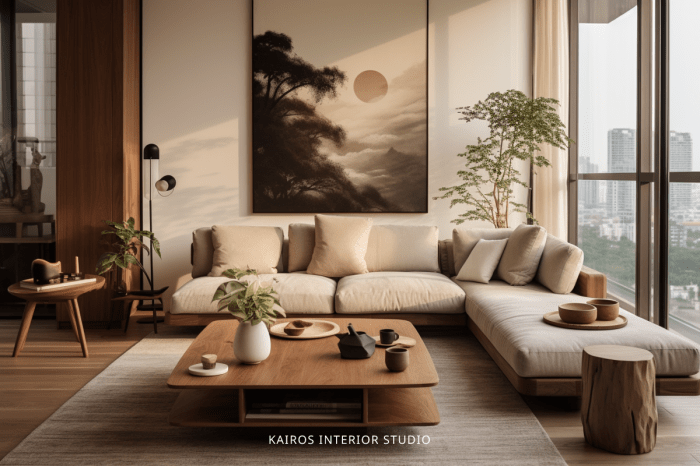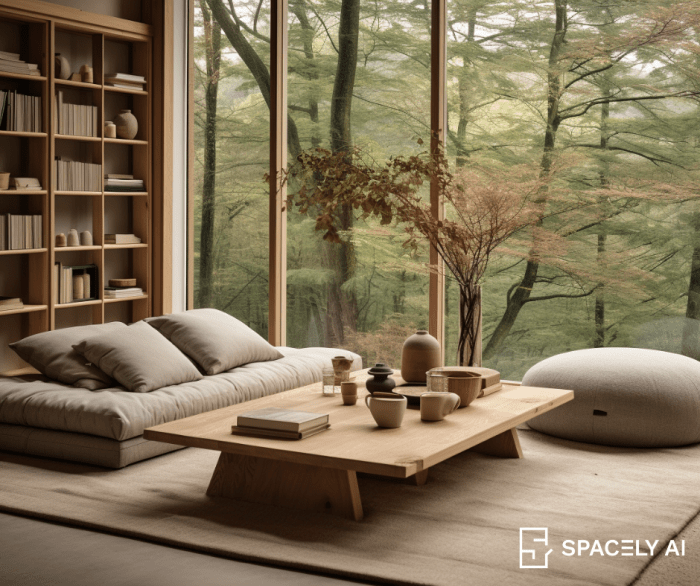Unlocking the Essence of Japandi Interior Design
Japandi interior design blends the best of Japanese minimalism with Scandinavian warmth, creating a harmonious fusion that captivates the senses. Dive into this captivating world where simplicity meets elegance, and functionality intertwines with beauty.
As we delve deeper, we uncover the intricate details that make Japandi design a unique and timeless trend in the world of interior decor.
Overview of Japandi Interior Design
Japandi interior design is a fusion style that combines the modern minimalism of Japanese design with the rustic warmth of Scandinavian decor. This hybrid aesthetic creates a harmonious and balanced living space that values simplicity, functionality, and natural elements.
Key Characteristics of Japandi Style
- Minimalistic Approach: Japandi design embraces clean lines, clutter-free spaces, and a less-is-more philosophy.
- Natural Materials: Wood, bamboo, stone, and other organic materials are commonly used to bring warmth and nature indoors.
- Neutral Color Palette: Japandi interiors feature a calming palette of neutral tones like whites, greys, and earthy hues.
- Functional Furniture: Furniture pieces are both stylish and practical, with a focus on multifunctional and versatile designs.
- Wabi-Sabi Influence: The Japanese concept of wabi-sabi, celebrating imperfection and impermanence, adds a unique charm to Japandi spaces.
Origins and Evolution of Japandi Design
Japandi design originated from the growing popularity of Japanese and Scandinavian aesthetics in the global design scene. The combination of these two styles emerged as a response to the need for simplicity, functionality, and coziness in modern living spaces.
Over time, Japandi design has evolved to incorporate elements of other design styles, such as hygge from Denmark, to create a more personalized and eclectic approach to interior design.
Color Palette and Materials

In Japandi interior design, the color palette is typically a mix of neutral tones and earthy colors combined with pops of muted pastels. This blend creates a calming and harmonious atmosphere that is characteristic of both Japanese and Scandinavian styles.The materials commonly used in Japandi design include natural elements such as wood, bamboo, rattan, and stone.
These materials are often left in their natural state or with minimal treatment to showcase their beauty and simplicity. Additionally, textiles like linen and cotton are used for soft furnishings to add warmth and texture to the space.
Common Color Palette
The color palette in Japandi interiors usually consists of a combination of whites, grays, blacks, and earthy tones like beige, taupe, and olive green. These colors create a sense of serenity and balance while allowing for a versatile and timeless aesthetic.
Common Materials
- Wood: Light or dark wood tones are prevalent in Japandi design, adding warmth and a sense of nature to the space.
- Bamboo: Often used for furniture and decor accents, bamboo brings a touch of Japanese influence to the Scandinavian simplicity.
- Rattan: Woven rattan furniture pieces provide texture and a natural element to Japandi interiors.
- Stone: Used for countertops, flooring, or decorative elements, stone adds a grounding and organic feel to the space.
The combination of the neutral color palette and natural materials in Japandi design creates a harmonious and cozy environment that promotes relaxation and mindfulness.
Furniture and Decor Elements
In Japandi interior design, the furniture and decor elements play a crucial role in creating a harmonious and balanced space that combines Japanese and Scandinavian aesthetics seamlessly.
Typical Furniture Pieces
- Low-profile furniture: Japandi interiors often feature low-slung sofas, platform beds, and coffee tables to create a sense of openness and simplicity.
- Clean lines: Furniture pieces in Japandi design are characterized by clean lines and minimal ornamentation, reflecting the minimalist ethos of both Japanese and Scandinavian styles.
- Natural materials: Wood is a predominant material used in Japandi furniture, with light-toned woods like oak and ash being popular choices. Other natural materials such as bamboo and rattan are also incorporated.
- Multipurpose pieces: Furniture in Japandi interiors is often multifunctional, serving both practical and aesthetic purposes to maximize space efficiency.
Minimalism in Furniture Design
In Japandi interiors, minimalism is embraced through furniture design by focusing on functionality, simplicity, and quality craftsmanship. Furniture pieces are selected for their clean and uncluttered look, avoiding excessive ornamentation or unnecessary details. This approach not only enhances the overall aesthetic appeal but also promotes a sense of calm and tranquility in the space.
Role of Decor Elements
- Textiles: Soft textiles like linen, cotton, and wool are used in Japandi interiors to add warmth and texture. Simple patterns and neutral colors are often preferred to maintain a sense of tranquility.
- Plants: Indoor plants are a common feature in Japandi interiors, bringing a touch of nature indoors and promoting a sense of harmony with the environment. Plants like bonsai, succulents, and bamboo are popular choices.
- Artwork: Minimalist artwork such as black and white photography, abstract paintings, and traditional Japanese prints are used to add visual interest and personality to the space without overwhelming the overall design.
Functionality and Simplicity

In Japandi interior design, the concepts of functionality and simplicity play a crucial role in creating harmonious living spaces that are both practical and aesthetically pleasing.
Emphasis on Functionality
Functionality is a key aspect of Japandi design, focusing on creating spaces that are efficient and serve a purpose. Every element in a Japandi interior is carefully selected to not only look beautiful but also to fulfill a specific function.
This design approach ensures that the space is not only visually appealing but also practical and comfortable for everyday living.
- Multi-functional furniture pieces, such as storage beds or coffee tables with built-in shelves, are commonly used in Japandi interiors to maximize space and functionality.
- Minimalistic and clutter-free layouts help maintain a sense of order and organization, reflecting the practicality of the design style.
- The use of natural materials like wood and stone not only adds a touch of warmth to the space but also serves a functional purpose by creating a connection to nature.
Simplicity in Japandi Interiors
Simplicity is achieved in Japandi interiors through a minimalist approach that focuses on clean lines, uncluttered spaces, and a neutral color palette. This simplicity allows for a sense of calm and tranquility in the space, promoting a peaceful and serene environment.
- Neutral colors like white, beige, grey, and black are commonly used in Japandi interiors to create a sense of simplicity and sophistication.
- Clean lines and geometric shapes are prevalent in furniture and decor pieces, contributing to the overall minimalist aesthetic of Japandi design.
- The use of negative space, also known as 'ma' in Japanese design, helps create a sense of openness and airiness in the space, enhancing the simplicity of the interior.
Concept of “Less is More”
In Japandi interior design, the concept of "less is more" is embraced to emphasize the beauty of simplicity and minimalism. By focusing on quality over quantity and eliminating unnecessary clutter and distractions, Japandi interiors exude a sense of elegance and refinement.
- Choosing a few statement pieces of furniture or decor items that are both functional and visually appealing can make a stronger impact than overcrowding the space with numerous objects.
- Creating a balanced and harmonious composition through the careful selection of elements ensures that each piece contributes to the overall aesthetic without overwhelming the space.
- By adhering to the principle of "less is more," Japandi design encourages a mindful and intentional approach to decorating, resulting in interiors that are both simple and sophisticated.
Wrap-Up

In conclusion, Japandi interior design offers a sanctuary of calmness and sophistication, where every element is purposeful and every space exudes tranquility. Embrace this aesthetic journey and infuse your home with the essence of Japandi for a truly inspiring living experience.
Answers to Common Questions
What defines Japandi interior design?
Japandi interior design combines Japanese minimalism with Scandinavian warmth, focusing on simplicity, functionality, and elegance.
What materials are commonly used in Japandi interiors?
Common materials in Japandi design include natural wood, neutral colors, and tactile textures to create a sense of tranquility.
How is minimalism incorporated into Japandi design?
Minimalism in Japandi design is reflected through clean lines, uncluttered spaces, and a focus on essential elements that enhance the overall aesthetic.
What role do decor elements play in Japandi interiors?
Decor elements such as textiles, plants, and artwork add warmth and personality to Japandi interiors while maintaining a sense of simplicity and balance.
How does Japandi design achieve simplicity?
Japandi design achieves simplicity through a decluttered space, natural materials, and a neutral color palette that create a serene and unobtrusive environment.




